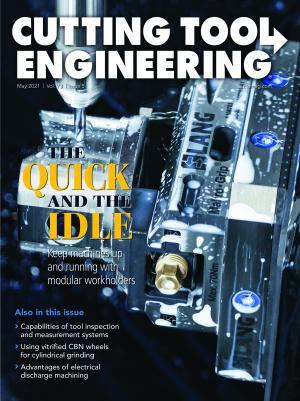Dear Doc: We have two dressers on our machine — one mounted behind the wheel and one mounted on the bed. Some operators like the one behind, and some like the one on the bed. Which do you prefer?
The Doc replies: My answer is the always popular “It depends.” There are four factors to consider, probably in this order: stiffness, cycle time, chatter and alignment. Let’s take them one by one.
First, rear-mounted, or top-mounted, dressing units consistently have less stiffness than those mounted on a bed. This may not be a problem. If it is, several issues can arise from a lack of stiffness.
Chatter could occur during dressing. With plunge rolls, this puts straight-line chatter into the wheel, which ends up being imparted into the workpiece in the form of straight-line chatter. With traverse-style dressing, this puts a “fish scale pattern” into the wheel, which imparts a fish scale pattern into the workpiece.
Longer dwell times could be required when rotary plunge dressing to get the final form, which can dull the wheel.
There could be deflection in the dresser, which can result in a taper in the wheel and therefore the part.
Again, if stiffness isn’t an issue, don’t worry about it. But if it is, you might pull out your hair trying to fix it.
Second, rear-mounted dressers allow you to dress while doing other stuff: cycling back, changing parts or even grinding itself during continuous-dress grinding. Eventually, these seconds can add up to weeks of increased production time.
Third, there’s a weird type of chatter called “2N chatter,” which is caused by differing stiffness in the x-axis versus the y-axis — assuming that the z-axis is the axis of rotation of your wheel. This makes the wheel pulsate twice per wheel revolution. Dressing on the same side that you grind on doesn’t eliminate this pulsation, but it dresses the pulsation pattern into the wheel, lessening the problem. Dressing on the opposite side that you grind on actually doubles the pulsation problem. Again, if it’s not an issue, it’s not an issue. Unless it is.
Fourth, if the bed of your machine has an alignment error, dressing on the same side that you grind on can sometimes — but not always — hide this error by imparting the same one into the wheel. It’s not textbook grinding, but it does improve things. On rear-mounted dressers, if there’s an alignment error in either the dresser or bed, the error isn’t going to correct itself. This is a frequent cause of “barber pole” in cylindrical traverse grinding.
That’s why old-school machinists have been known to say, “Dress and grind on the same side.” It doesn’t always matter. But when it does, it does.
So I’m all for rear- or top-mounted dressers as they can save time. But they do add potential issues that you need to be aware of.
Related Glossary Terms
- chatter
chatter
Condition of vibration involving the machine, workpiece and cutting tool. Once this condition arises, it is often self-sustaining until the problem is corrected. Chatter can be identified when lines or grooves appear at regular intervals in the workpiece. These lines or grooves are caused by the teeth of the cutter as they vibrate in and out of the workpiece and their spacing depends on the frequency of vibration.
- dressing
dressing
Removal of undesirable materials from “loaded” grinding wheels using a single- or multi-point diamond or other tool. The process also exposes unused, sharp abrasive points. See loading; truing.
- grinding
grinding
Machining operation in which material is removed from the workpiece by a powered abrasive wheel, stone, belt, paste, sheet, compound, slurry, etc. Takes various forms: surface grinding (creates flat and/or squared surfaces); cylindrical grinding (for external cylindrical and tapered shapes, fillets, undercuts, etc.); centerless grinding; chamfering; thread and form grinding; tool and cutter grinding; offhand grinding; lapping and polishing (grinding with extremely fine grits to create ultrasmooth surfaces); honing; and disc grinding.
- stiffness
stiffness
1. Ability of a material or part to resist elastic deflection. 2. The rate of stress with respect to strain; the greater the stress required to produce a given strain, the stiffer the material is said to be. See dynamic stiffness; static stiffness.


